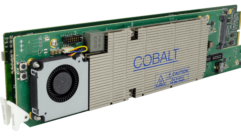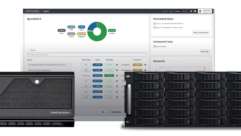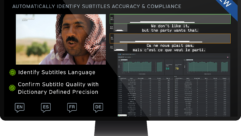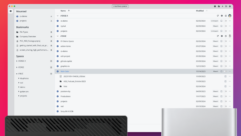This year’s NAB was the cause of much speculation on the part of attendees. Would attendance hold steady, or drop? How would the slow transition to DTV affect products and attendance? Would manufacturers of projectors, monitors, and interfaces continue to support the show?
First things first. Yes, attendance was down 16% this year, continuing a trend from 2001. However, NAB is a very large trade show to begin with, and grew exponentially (well over 100,000 attendees) since Multimedia World was added in 1994. Perhaps NAB has simply gotten too large, like Comdex?
Despite the addition of a new South Hall for exhibitors, there were still many exhibits back at the old Sands Expo Center. This was a pain in the neck for members of the press, most of whom were led to believe that everything would be situated in the Las Vegas Convention Center. Part of the new South Hall was blocked off on the lower level, and the North Hall was largely used to show off remote trucks. Seems to me those spaces could have been allocated more intelligently.
Last year, some manufacturers of displays and interfaces told me that a return to the show in 2002 was in question for them. Indeed; several manufacturers opted out completely this year. Notable by their absence were InFocus (not a previous attendee in recent years, but they did book space), Altinex, InLine, Electrosonic’s display systems group, and Digital Projection. Epson (like some other companies) opted to stay off the show floor, instead conducting their meetings from the relative calm of a suite in the Four Seasons Hotel.
All in all, the smaller crowds made it easier for cell phone calls, and there was plenty of room to check out the latest offerings from those display manufacturers who did show up. Here are some highlights:
Barco got a pick hit award from Video Systems for its revolutionary IQ G300 front LCD projector. In addition to being totally network-ready, this unique design has a built-in seamless switcher and scalar for mixing interlaced and progressive-scan signals at any resolution. You can also tile up to four signal sources in windows at any size, in any order, and at any depth. The IQ G300 has XGA (1024×768) native resolution and is rated at 3500 lumens, and also sports a dual-lamp mode that lets you choose either extra light output, or longer lamp life with automatic changeover in case of a failure.
Seamless switching and scaling are also available on the new ELM R18 Director (18,000 lumens) and SLM R8 (XGA) and G8 (SXGA) 8,000 lumens projectors. Plus, Barco announced an upgrade to their DLP Cinema line with the D-Cine Premiere DP40 and DP50 chassis’. Both models have the latest Dark Metal 3 DMD devices for enhanced contrast, a sealed optical engine, dust-proof digital head, and automatic liquid cooling system.
NEC Technologies had a new digital cinema projector in their demo room. The TriDigital HD4K is a 3500 lumens, SXGA DLP design that incorporates NEC’s proprietary TriDigital gamma and color correction, allowing users to match the characteristics of motion picture film stocks. There was also a new 42″ high-resolution plasma on display, the PlasmaSync 42MP4. This design employs a 1024×768 non-square pixel matrix (yes, it’s a 16×9 panel), plus AccuCrimson for improved red rendition, AccuBlend for auto image scaling, and a host of protections against image burn-in.
Christie Digital Systems finally plugged a hole in their product line with several new desktop/installation LCD projectors. The VIVID LX35 is a 18-pound, 3500 lumens box with XGA (1024×768) native resolution, while the VIVID LX26 is a tad lighter at 17 pounds and cranks out 2600 lumens. In a first, Christie now has an ultraportable model, the 8.6 pounds VIVID LX20. It’s also XGA with 2000 lumens output. (There is a remarkable resemblance between these models and similar offerings from Sanyo, by the way…)
Christie also updated their digital cinema line with the DCP-H and DCP-I projectors. The DCP-H is a full-bore DLP Cinema model for theaters and exhibitors, while the smaller DCP-I is intended for smaller screens, such as boutique cinemas and post-production houses. For the command and control marketplace, Christie offers the GraphXMaster RPMS-500Xe tiling projector. This DLP projection module is rated at 1000 lumens and provides SXGA (1280×1024) native resolution.
Sanyo had a nicely laid-out booth this year, touting their PJ-Net Organizer control software and Multi-versatile Interface Platform for aftermarket plug-in video processing cards. New products include the PLC-XP46 and PLC-XP41, both XGA-resolution desktop/installation projectors that weigh less than 20 pounds and are rated at 4100 and 3300 lumens, respectively. The PLC-XF40 is a new XGA installation chassis with numerous interchangeable lenses, a fail-safe quad lamp system, and a spec of 7700 lumens (which may be the brightest LCD projector available anywhere).
There were also a pair of new 9.5 pound portable models, the PLC-XU31 (XGA) and PLC-SU31 (SVGA), both rated at 1700 lumens. All models are fully compatible with DTV signals, too. The most interesting projector was the PLV-70T, a boardroom/conference room (and probably home theater) product with native 1366×768 pixel LCD panels and a unique color management system that lets you select specific luminance and color values in a scene and correct for them only.
Mitsubishi didn’t have a huge presence at the show, but one product in their booth drew a lot of attention. The VS-60XT20U is a 60″ diagonal 4×3 rear-projection monitor using 1024×768 DLP imaging (single chip with color wheel), but in an amazingly-thin 10″ deep cabinet. How’d they do it? Supposedly, the multiple mirror design results in a somewhat elongated (keystoned) projection of the DMD pixels from top to bottom, and all signal sources are re-mapped to compensate.
Panasonicbrought out a pair of new 4:3 HD-compatible LCD monitors for broadcast use. The BT-LH1800 is an 18″ design with 1280×1024 resolution, while the BT-LH1500 is an XGA-native 15″ design. Both models come standard with NTSC and PAL inputs, and you can plug-in optional cards for HD-SDI, SDI, and analog RGBHV compatibility.
At an off-site suite, Epsonannounced a trio of new LCD projectors. The PowerLite 720c (XGA, 1500 lumens) and PowerLite 730c (XGA with micro lens array, 2000 lumens) are supposedly the brightest projectors in their weight class – just 4.3 pounds. For the desktop/installation market, Epson has upgraded to the PowerLite 8200i. It features XGA resolution and is rated at 3500 lumens output, can accept four different lenses, and weighs about 18 pounds. All three models are fully DTV-compatible.
Sony had two new plasma monitors hanging at the entrance to their mammoth AnyCast booth. The PFM50C1 is the first 50″ product for Sony and comes standard with composite and S-video inputs, plus dual 15-pin analog ports. There are expansion cards for component and digital inputs, plus LAN control. (This panel uses 1365×768 pixel NEC glass, by the way.) The PFM32C1 is a 32″ model with similar I/Os, and has a native resolution of 1024×852 pixels. It weighs less than 50 pounds, too. (Remember how much 32″ tube monitors weighed?)
Hitachi used NAB to announce the CP-X990W desktop/installation LCD projector. It weighs 14 pounds, has XGA native resolution, and is rated at 3500 lumens. It’s also DTV-ready, as is the compact CP-X430W, a 2500 lumens XGA design that weighs a tad under 10 pounds. This LCD “box” also has DVI input, which is starting to pop up on a lot of LCD projector designs.
Zenith was touting a pair of 16:9 plasma monitors for broadcast and post production use. The 50″ P50W26 has 1366×768 native resolution, built-in Faroudja/Sage de-interlacing and motion compensation ICs (look for more companies to adopt this chipset), compatibility to SXGA, DVI input, and full compatibility with DTV standards. The 42″ P42W22 is a 852×480 pixel (Wide VGA) design with the same features, except the DVI connector.
JVC had a demo of their DLA-QX1 digital cinema projector way back in the remote reaches of the central hall meeting rooms, but it was worth the trouble to find. This model uses 2048×1536 D-ILA imaging panels, and the demos consisted of transfers from The Shipping News, Amelie, and HD footage from the tonight show. The projector looks better each time I see it, but still needed a bit more contrast punch and lower black levels.
Lighthouse showed a brand-new indoor LED matrix display, the LVP0630. It has a fine pixel pitch of 6mm, a 4:3 aspect ratio, and is rated at 3000 nits brightness. The 10mm LVP1030 is rated at 3000 nits and suitable for indoor and outdoor use. Lighthouse’s company’s M4 processor is used with both models to maintain even modulation across all pixels and 13-bit signal processing is used for better grayscale reproduction.
Extron continued its push into room automation with an expanded line of MediaLink control interfaces. While not on the level of a full-blown Crestron or AMX system, there is a need for simple, economical controllers like these. The basic MLC206 controller has a tiny control panel with simple pushbuttons, while four models of remote MediaLink switchers are available for control of video and computer signals.
Extron also had the FPC 5000, a full-blown LCD touchscreen interface for their Matrix 12800 switcher. This interface is a full TCP/IP connection with automatic timed status updates, redundant power supplies in the switcher, and automatic email alerts in case of failures. The 12800 is a 128×128 matrix with monitored airflow (it’s got lots of fans) and is designed for out-of-the-way installation and operation.
The folks at Kramer not only enjoy Las Vegas Area 51s minor league baseball big time, but also had some neat new products to be seen in the South Hall. Their FC-1ETH is a bi-directional interface that allows RS-232C devices to be operated via TCP/IP, USB, and 802.11b wireless. The FC-2000 is a full-bore audio format transcoder with support for analog balanced, AES/EBU, S/PDIF, and optical I/Os.
Kramer’s VS-1604YC is a 16×4 vertical interval matrix switcher for Y/C signals with audio follow, while the VS-1616V/A/D series of 16×16 matrix switchers are designed for composite video, analog audio, and digital audio, respectively. For presentations, there’s the VP-25×1 seamless switcher/scalar that supports XGA output resolution. It actually has 4×1 performance with composite, S-video, and RGB signals, plus audio follow. To top things off, Kramer unveiled their model 810 (analog) and 820 (SDI) compact color bar generators.
RGB Spectrum had some nice “views” in the rear of the South Hall with the SuperView, QuadView, 4View, and DualView video/RGB windowing/tiling systems. The SuperView accommodates up to 10 video/RGB inputs, while the QuadView will accept up to four RGB (video optional) sources. The 4View is a video-only “tiler” (composite, S-video, SDI) and the DualView handles one video and one RGB source.
Folsom had a display set-up that momentarily took me back to the good ol’ days of multi-image slide projection (may they rest in piece). Using the new VFC-2200DE digital scalar, they were projecting a seamless 8:3 widescreen image using a center overlap, then dropping individually tiled windows of HD/SD video and still images across that panorama. All functions were operated from a Vista Control Systems custom switcher, and at one point a center crop of an HD image was the widescreen panorama.
Communications Specialties had a full range for their Pure Digital FiberLink products on display, including models for porting video and RGBHV signals with audio (and even data) over long fiber runs. Fiber has become inexpensive enough that it is a reasonable alternative to Cat5/6 LAN-style wiring, but with potentially higher bandwidth. The popular Duece scalars were on hand, including the Deuce SDQ. This economical interface converts composite, S-video, or component 480i to any one of five progressive-scan output formats compatible with computer displays.
Finally, QuVis has expanded its line of “any format” servers to address markets such as broadcast, theme parks, retail, and post-production. The QuBit 601 is a true, uncompressed ITU-601 10-bit recorder/player with 8 channels of digital audio, and it can also be upgraded to HD capability. The QuBit EL (entry level, multiformat/frame-rate) and ST (compatible with VESA and SD/HD formats) servers have also been upgraded to 10-bit capability.










